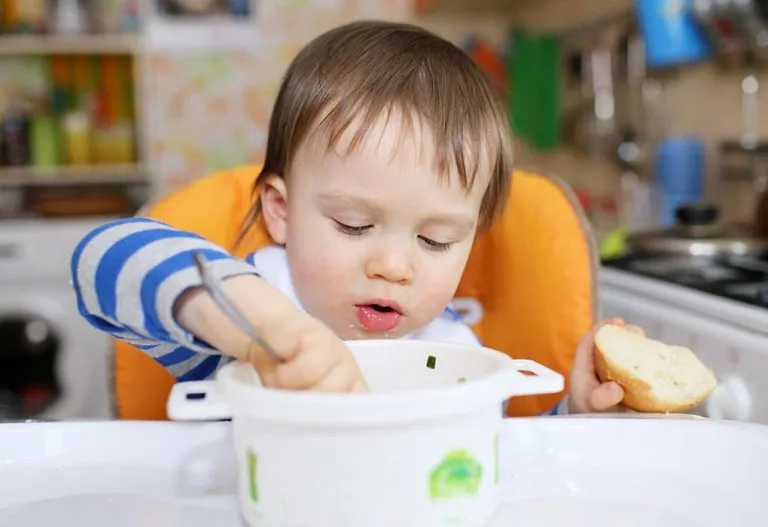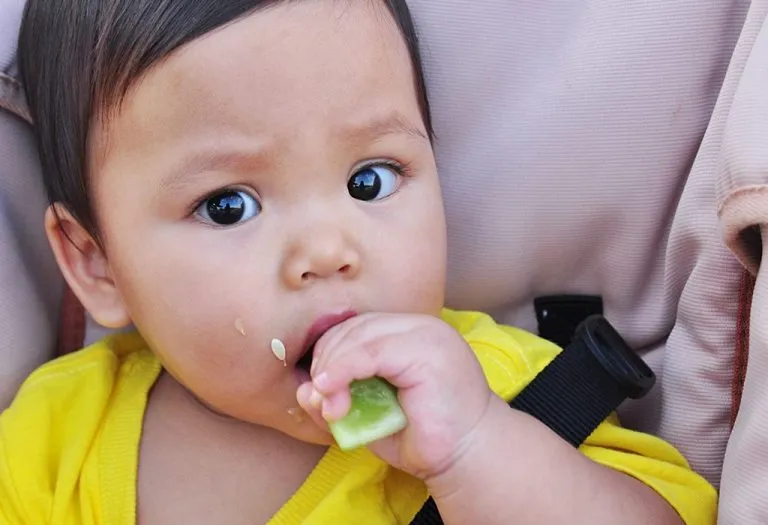6 Month Old Baby Feeding Schedule, Recipes and Tips
- What to Feed a 6-Month-Old?
- How Much Milk Is Enough for a 6-Month-Old?
- Feeding Schedule for a 6-Month-Old
- Foods to Avoid for a 6-Month-Old Infant
- Baby Food Recipes for 6-Month-Olds
- Feeding Tips for Parents
- FAQs
At the 6-month mark, your baby will be ready to start experimenting with pureed foods. But remember that we use foods here as supplements. According to the American Academy of Pediatrics, your child’s prime source of nutrition will still be infant formula or breast milk to support them nutritionally since they will be adapting to new food habits for up to two years (1). Most babies start with cereals, oatmeal, and rice as their first foods. But some skip straight to pureed vegetables, fruits, and meats.
If you want to learn more about 6-month-old feeding schedules along with delicious baby food recipes and tips, continue reading…
What to Feed a 6-Month-Old?
When you first start feeding your baby, you don’t want to mix your breast milk with cereal. Most babies end up wasting it, which is why it’s a good idea to let them sample first. Mix some water with your cereal and let your child taste it. If they like it, gradually add your breastmilk. Breastmilk mixed with cereals like oats provides iron for your baby. However, oats are bulky and fill the baby’s tummy quickly. Therefore, they can be started after your baby can digest basic cereals. Cereals also serve as a nice transition to pureed and other finger foods. Finger foods can be added after the baby starts having some soft, cooked, small food particles other than the purees. Plus. they also help with eye-hand coordination (2).
If you’re feeding your child cereal, see if they stick to one feeding for at least two weeks. After that, you can increase it to two feedings and introduce new foods. Orange and yellow vegetables are what kids go for first, but some kids prefer bananas, which should be included in your baby’s diet in mashed form, and cooked avocados for their first pureed foods. Wait for at least three days before giving your child a new food because that will help you pinpoint any food intolerances and allergies, which should be taken seriously. You must consult your paediatrician in the case of an allergy or food intolerance and take the necessary precautions.
1. Fruits/Vegetables
For fruits and vegetables, here’s what you can feed your child:
- Bananas
- Avocados
- Tofu or sauteed cottage cheese
- Pumpkin
- Mashed or sliced sweet potatoes
- Boiled Beans
- Oranges
- Watermelon (seedless)
- Berries
2. Non-Vegetarian
Animal foods are a good source of iron, protein, amino acids, and key essential nutrients. Here are the foods you can add to your baby’s eating schedule:
- Scrambled eggs
3. Other Food Items
Other food items you can also add to the meal plan for your 6-month-old baby are:
- Cheese (plant-based)
- Butter (plant-based, in moderation)
- Muffins
- Lentil soups or broths
- Unsweetened yogurt (lactose-free)
How Much Milk Is Enough for a 6-Month-Old?
How many ounces of milk for 6-month-old children is enough? The quantity of milk you’re feeding your child will matter when you feed breastmilk or formula. So, how much a six-month-old should eat when it comes to milk? Generally speaking, a formula-fed baby feeds four to five times a day, while breastfed babies will be fed five to six times a day (3). After your baby gets used to the feeding schedule, you can add solid foods to the food chart depending on the baby’s tolerance and acceptance of solids. When eating solids, it’s normal to cut down on breastmilk or infant formula since your baby may feel too full.
Feeding Schedule for a 6-Month-Old
The key thing about sticking to a feeding guide is ensuring your child feels satisfied after every meal. And being consistent with your feeding times is a good way to stay on track. We’ve listed a few sample six-month-old feeding schedules to give you an idea about how much solid food you can feed your baby. These
1. Schedule for Formula-Fed Babies
Here is a sample feeding schedule for formula-fed babies for your reference keeping in mind your 6-month-old nursing schedule:
| Time | What to Feed |
| 7 AM | 6 ounces of infant formula. |
| 10 AM | Breakfast, including mashed fresh fruit or fortified cereals. |
| 2 PM | Lunch with a bottle of formula and a serving of pureed fruits and vegetables. |
| 5:30 PM | Two to three servings of fruits and vegetables (mashed or pureed). |
| 7 PM | For dinner, only infant formula before bedtime. |
2. Schedule for Breastfed Babies
You can use this sample feeding schedule for breastfed babies and alter it as per your child’s needs:
| Time | What to Feed |
| 7 AM | Nursing the baby for 20 minutes after waking him up. |
| 8:30 AM | Oatmeal cereal or a similar breakfast, along with a portion of fresh fruit. |
| 12:30 PM | Breastmilk feeding for 20 minutes. |
| 3 PM – | Lunch with a serving of vegetables (up to 3 ounces). |
| 5:30 PM | Breastfeed or a bottle of breastmilk. |
| 8:15 PM | Dinner, which includes two ounces of breastmilk mixed with oatmeal cereal and two ounces of pureed veggies. |
We hope you benefitted from each food schedule for 6-month-olds for breastfeeding and formula-fed babies.
Foods to Avoid for a 6-Month-Old Infant
Most parents also wonder if they can feed all solid foods to their babies. The answer to this is yes, but not anytime soon. To be clear, here is a list of foods to avoid from your 6-month-old meal schedule (4) (5):
- Solid Foods in the Form of Big Chunks: Foods in big chunks, such as big pieces of carrots, cauliflower florets, etc., can be a choking hazard. Soft, boiled, small, or sliced pieces can be given rather than big chunks. If you think small pieces are also difficult for the baby to swallow, mash them further.
- Raw Milk: Raw milk or anything with lactose is a big no since 6-month-old babies can’t digest milk proteins.
- Raw Honey: Raw honey causes infant botulism as it contains spores or microorganisms. Because your baby’s digestive tract is still immature at this age, their stomach does not produce enough acids to fight bacteria in their digestive tract.
- Fish: Special varieties of fish like tuna or those with high levels of mercury and heavy metals are best avoided when your baby is weaning.
- Fruit Juices: Fruit juices contain zero fibre and concentrated sugars.
- High-Sugar/Sodium Foods: Foods high in sugar like candies, chocolates, and soft drinks and foods high in sodium like crackers, pickles, etc., should be avoided.
Baby Food Recipes for 6-Month-Olds

Here are some simple food recipes apt for a 6-month-old baby. They take a few minutes and can be made with a few staple ingredients. These will help you create your customized baby diet planner, too.
1. Banana Puree
Banana puree is one of the most popular foods for a 6-month-old baby. Be sure not to overdo it, though, since too much banana can cause constipation; a little bit is fine and is okay for a treat. Remember that any food that your baby can tolerate is fine to be given in moderation.
Ingredients
Here’s what you’ll need for this:
- Ripe bananas
- Breastmilk or infant formula
How to Prepare
Here is how you prepare it:
- Take a banana and a fork.
- Mash the banana and make a puree out of it.
- Add in a bit of breast milk or infant formula to thin down the consistency.
- Serve fresh.
2. Avocado Puree
Avocado is rich in healthy plant-based fats and promotes proper brain development in kids. Children love the unique and flavourful texture of the puree, which is why it’s one of the top foods to give 6-month-old babies.
Ingredients
Here is what you will need for this recipe:
- Organic avocados
- Breastmilk or infant formula
How to Prepare
- Get an organic avocado and start by cutting it.
- Mash it into a puree with a metal fork or use a food processor to make this step easier.
- Serve it fresh and thin the consistency by mixing the puree with breastmilk or infant formula.
3. Brown Rice Baby Cereal
If you’re looking for a dinner recipe for your little one, this one is perfect. Let your baby try it and see the reaction on their face.
Ingredients
You need two ingredients for this recipe:
- 1/4 cup brown rice or white rice, preferably parboiled
- 4 cups of water
How to Prepare
Making this recipe is easy, and it’s also very nutritious. Here are the steps:
- Take 1/4 cup of parboiled brown or white rice and grind it through a food processor till you get a fine powder.
- Heat some water in a pot and add in the ground rice.
- Bring the mix to a boil and let it simmer on low heat for 20 minutes.
- When it looks pureed enough, take it out, drain and let it cool a bit.
- Serve it to your baby.
Feeding Tips for Parents
If you’re trying to feed your baby, you want to make sure you do it right. Learn about feeding tips and more below:
1. When to Feed
These tips will help you understand when to feed your baby:
- Aim for two feedings a day for breast milk/formula. Along with pureed and solid foods, your baby should be getting six meals a day in total.
- Start giving solid foods slowly. Waiting too long to start can cause feeding problems later on.
- Give solids in the morning and solids again during the evenings. Start with small amounts and increase the quantity gradually as you continue breastfeeding. If your baby cries or is famished, don’t give him solids; breastfeed him instead.
- Always look for their behavioural and emotional cues before feeding. Experiment with finger foods for snacks and make mealtimes enjoyable.
2. How to Feed
Here is what you should do when you start feeding your baby:
- Make sure your baby is seated comfortably and upright. Use a belt to fasten so that they don’t fall off the chair when you’re not watching.
- Scoop out the pureed food using a spoon and gently bring it close to their mouth.
- Let them taste it. If they are in the mood to eat, they will eat it.
- Don’t wait too long before feeding because your child won’t understand what you’re doing. But don’t push the spoon into their mouth, either. Place it on their lips and see how they respond.
- If your baby doesn’t feel like eating, don’t force them. Try again later. Feeding times should feel pleasant and natural.
- Sit down with your family along with the baby at the dinner table during meal times. It’s a great way to bond and encourage them to eat.
FAQs
1. Can I give water to my 6-month-old child?
Yes, you can feed water to your 6-month-old child in small amounts from a straw or open cup. Do not give water to your little one throughout the day as for now breast milk an formula milk are enough to provide the maximum hydration.
2. Should I watch out for allergies when introducing new foods to my 6+ child?
In a study published in Pediatrics, introducing high-risk allergen foods like peanuts, eggs, and dairy may help lower the occurrence of or prevent food allergies in children. In fact, there is certain evidence that the early introduction of peanuts to children may prevent peanut allergies (6). However, before introducing allergen foods to your child’s feeding routine, we recommend consulting a paediatrician.
3. How frequently should 6-month-old children be fed?
At around 6 months old, babies usually eat every 3 to 4 hours during the day. If they’re breastfeeding, they might eat even more often. It’s also normal for babies this age to wake up 1 to 2 times during the night to eat.
4. Why is my 6-month-old baby not eating as usual?
There could be a few reasons why your 6-month-old is eating less than usual. It could be because they’re teething, feeling a bit under the weather, or they’re just not as hungry. As long as they’re still growing, there’s usually nothing to worry about.
5. How can I know if my 6-month-old is getting enough feeds?
To check if your baby is getting enough to eat, you can keep an eye on their diapers. For newborns, having 2 to 3 wet diapers a day in the first few days after birth is a good sign. As they grow, around 4 to 5 days after birth, you should see at least 5 to 6 wet diapers a day. How often they poop can vary, and it depends on whether they’re breastfed or formula-fed (7).
6. Which is the ideal milk for my baby after 6 months?
According to MedlinePlus, it is best to continue breastfeeding your baby for at least the first 6 months of their life. You should give only breast milk or iron-fortified formula milk for the first 12 months of life to safeguard their health from potential health concerns. Cow milk before 1 year of life should be avoided (8).
Watching your six-month-old baby grow into a healthy child can be a wonderful experience. Be sure to check if they are gaining weight steadily and take time with your meal prep and planning. By adding a variety of easily digestible foods and following simple but consistent routines, you’ll soon find your baby eating loads of healthy foods in no time.
References/Resources:
1. Starting Solid Foods; American Academy of Pediatrics; https://www.healthychildren.org/English/ages-stages/baby/feeding-nutrition/Pages/Starting-Solid-Foods.aspx
2. From around 6 months; NHS; https://www.nhs.uk/start-for-life/baby/weaning/what-to-feed-your-baby/from-around-6-months/#:~:text=You%20can%20start%20weaning%20with,offering%20it%20to%20your%20baby.
3. Feeding Guide for the First Year; Stanford Medicine; https://www.stanfordchildrens.org/en/topic/default?id=feeding-guide-for-the-first-year-90-P02209
4. Foods to avoid giving babies and young children; NHS; https://www.nhs.uk/conditions/baby/weaning-and-feeding/foods-to-avoid-giving-babies-and-young-children/
5. Foods to Avoid for Baby; Government of Newfoundland and Labrador; https://www.gov.nl.ca/healthyeating/baby/offering-healthy-foods/foods-to-avoid-for-baby/
6. Greer. F. R, et al.; The Effects of Early Nutritional Interventions on the Development of Atopic Disease in Infants and Children: The Role of Maternal Dietary Restriction, Breastfeeding, Hydrolyzed Formulas, and Timing of Introduction of Allergenic Complementary Foods; Pediatrics; https://publications.aap.org/pediatrics/article/143/4/e20190281/37226/The-Effects-of-Early-Nutritional-Interventions-on?autologincheck=redirected; April 2019
7. How Often and How Much Should Your Baby Eat?; American Academy of Pediatrics; https://www.healthychildren.org/English/ages-stages/baby/feeding-nutrition/Pages/How-Often-and-How-Much-Should-Your-Baby-Eat.aspx
8. Cow’s milk – infants; MedlinePlus; https://medlineplus.gov/ency/article/002448.htm#:~:text=If%20possible%2C%20you%20should%20feed,foods%20to%20your%20baby’s%20diet.
Also Read:
7 Month Old Feeding Schedule
Feeding Schedule for 8 Month Old
9 Month Baby Feeding Schedule and Recipes
Was This Article Helpful?
Parenting is a huge responsibility, for you as a caregiver, but also for us as a parenting content platform. We understand that and take our responsibility of creating credible content seriously. FirstCry Parenting articles are written and published only after extensive research using factually sound references to deliver quality content that is accurate, validated by experts, and completely reliable. To understand how we go about creating content that is credible, read our editorial policy here.
























